Theme
This paper discusses the key green transition elements in Germany’s Recovery and Resilience Plan (NRRP), that amount to 42.7% of the funds and largely focus on fostering zero emissions mobility, developing hydrogen capabilities and enabling climate-friendly construction and renovation.
Summary
The German National Recovery and Resilience Plan (NRRP) presents a strong pro-European commitment for economic recovery and constitutes a re-commitment to existing climate, sustainability and energy targets. The plan was jointly presented with France, and submitted to the European Commission alongside France, Spain and Italy. Germany was indeed quick to approve the plan in December 2020 and to include its measures in the Federal Budget from 2021 onwards. While the plan itself has received little public attention in Germany, some critics point to a lack of ambition and the absence of specific or quantifiable targets. Indeed, the plan is more focused on the input side, i.e., financial spending, rather than the output side, i.e., the specific objectives to be pursued. It can thus be understood as a strategic outline for the medium term. Out of the total investment of €29.3 billion in the German NRRP, 42.7% are devoted to the issue of Climate Policy and Energy Transition, which includes several programmes related to hydrogen and sustainable mobility and, to a lesser extent, sustainable housing.
Major individual investments are centred around the National Hydrogen Strategy (with both a focus on energy supply and mobility), Franco-German cooperation for a future hydrogen economy and the development of alternative sustainable mobility (electric mobility and hydrogen-based mobility where direct electrification is not possible). The measures are well aligned with prior efforts Germany has undertaken in the context of sustainability and energy transition and can thus be regarded as feasible. An overview of the measures, investment volumes and aims is provided in Figure 4.
Upcoming General Elections in September 2021, together with various elections in the Länder, will likely result in a very significant increase in the share of seats going to the Green Party. As a result, it seems likely that the level of climate ambition will increase over and above the recent increase in Germany’s ambition.
Finally, the lack of specific quantifiable targets per investment programme or measure should be addressed. A proper enabling framework for the sustainability transition should be on the to-do list of the next Government, allowing for coordinated steering of the energy and mobility transitions, the transition to a circular economy, the creation of a hydrogen economy and European cooperation, amongst others.
Abbreviations
NECP: National Energy and Climate Plan
NRRP: National Resilience and Recovery Plan
Analysis
(1) Introduction
On 27 April 2021 France and Germany jointly presented their National Recovery and Resilience Plans (NRRP) and submitted them to the European Commission and Council along with Spain Energy and Italy. The French Economy Minister, Bruno Le Maire, said in the press conference with German Finance Minister Olaf Scholz that ‘it was important for us to do this presentation together, as Germany and France have been working hand in hand since the beginning of the crisis’.
The German NRRP amounts to over €29 billion in total (€25.6 billion in EU grants plus Federal Funding) and plans to devote around 40% thereof to the climate-related investment included in Chapter 1 on Climate Policy and Energy Transition. It was approved by the German Bundestag in December 2020 and the corresponding investments are included in the 2021 Budget of the Federal Republic of Germany. 1
Germany follows two main guiding principles for its NRRP, namely a strong pro-European commitment and cooperative approach for economic recovery on the one hand, and on the other a strong re-commitment to climate, sustainability and energy transition targets already in place, i.e., through the Paris Agreement, the German Energy and Sustainability Transition laws, the National Energy and Climate Plan (NECP), etc. As such, the German NRRP explicitly recognises the importance of the EU and coordinated and well-aligned action of the EU Member States to overcome the COVID-19 crisis but also to safeguard the future of Germany and Europe as regards sustainability (German NRRP Draft Version, 2021, p. 3).
In the German NRRP, the chapter on Climate Policy and Energy Transition contains the decarbonisation of economic sectors with special attention to renewable (green) hydrogen, climate-friendly mobility and climate-friendly construction. The digital transformation chapter of contains digitalisation efforts regarding infrastructure and private sectors, data as raw material, digital public administration and digital education (German NRRP, 2021, p. 3). Some of these proposed efforts are interlinked with the chapter2 on Climate Policy and Energy Transition and will be detailed in the remainder of this paper.
As transition mechanisms to a cleaner and more digital economy and society, the German NRRP highlights the importance of investment in innovation, education and the central role of energy transition. Ultimately, the German NRRP outlines the objective that the EU and Germany become resilient and future-proof (German NRRP, 2021, p. 3). Engaging in these transition mechanisms is understood to be a European and cooperative endeavour amongst all EU Member States. The close cooperation and importance of the Franco-German engine for the EU is explicitly highlighted throughout the document.
Lastly, the EU and Germany engage in a large volume of public spending in the context of Next Generation EU and the NRRPs, ensuring economic recovery and future prosperity. On the other hand, the German NRRP mentions that the long-term sustainability of public finances in the EU and its Member States should be ensured (German NRRP, 2021, p. 3).
Surprisingly, both the German NRRP itself and the political process of its preparation have largely gone unnoticed to the general public and were not reflected in the political debate related to the health and socioeconomic crisis caused by COVID-19. Upon presentation, the German NRRP was criticised for being unambitious, a mere ‘mix’ of older proposals instead of a dedicated reconstruction strategy and being too vague, as there were no specific (quantitative) targets and objectives.3 Yet these criticisms did not receive much attention.
In the following paragraphs the German NRRP will be presented, its measures will be classified and critically analysed, and some policy recommendations for future improvements will be derived.
(2) Main objectives of the German Recovery and Resilience Plan and its alignment with European strategies and targets
The German NRRP consists of six chapters:
- A Strategy for Climate Policy and Energy Transition.
- Digitalisation of the Economy and Infrastructure.
- Digitalisation of Education.
- Strengthening Social Inclusion.
- Strengthening a Pandemic-resilient Healthcare System.
- A Modern Public Administration and Reducing Barriers to Investment.
Amongst these, the total amount of €29.3 billion is distributed as shown in Figure 1. Chapter 1 on Climate Policy and Energy Transition receives 42.7% of total funding. It is thus the chapter that receives the greatest financing.
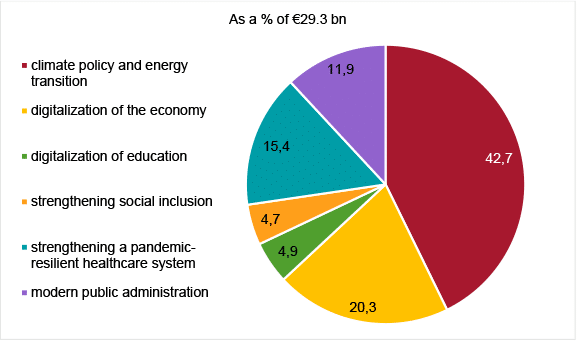
The German NRRP explicitly states that Germany faces major challenges in the area of climate protection (German NRRP, 2021 p. 7). The objective is to reach large-scale decarbonisation to stop human-induced climate change. At the same time, decarbonisation should be achieved without a decline in quality of life, value creation or employment. Germany considers that economic policy plays a major steering role in that context. Specifically, the country addresses three pillars within Chapter 1 of Climate Policy and Energy Transition:
- Pillar 1: renewable (green) hydrogen
- Pillar 2: climate-friendly mobility
- Pillar 3: climate-friendly construction and renovation
In total, the 42.7% of expenditure of the German NRRP assigned to these pillars in Chapter 1 corresponds to around €12.5 billion. Climate-friendly mobility is the single most important pillar with around € 6.6 billion, accounting for half of the budget in the Chapter and for around one quarter of the total German NRRP expenditure.
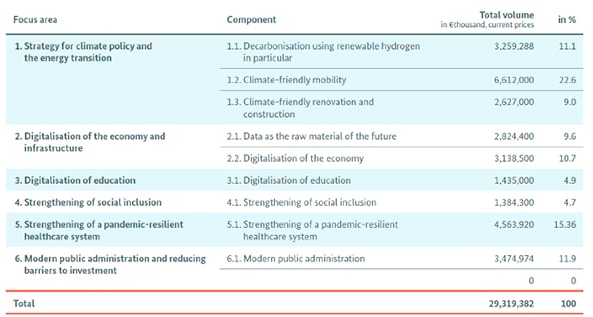
Within these three pillars, there are the following sectoral investment programmes (see also Figure 4 for more details).
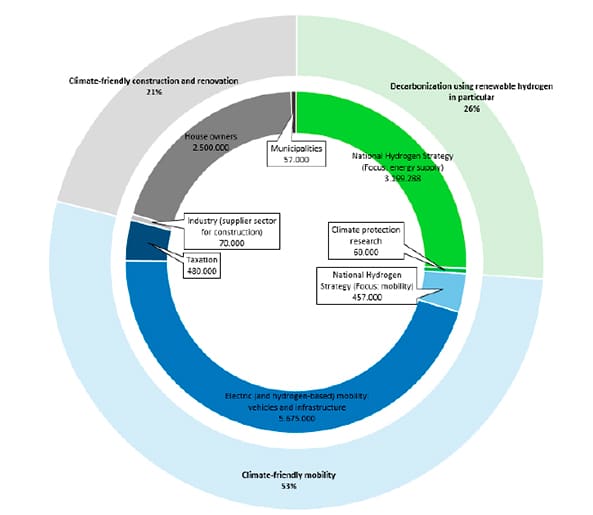
The German NRRP is aligned with European strategies and targets. Specifically, the EU flagship initiative programme serves as a guide:
- EU flagship 1 (Power Up) on energy
- EU flagship 2 (Renovate) on housing
- EU flagship 3 (Recharge and Refuel) on mobility
Regarding energy, the EU aims to introduce early stage ‘future-proof’ renewable energy technologies into the market and accelerate their market uptake through network integration and interconnectivity, i.e., a 40% RES electricity share and corresponding 200 GW installed capacity target by 2030. For hydrogen, by 2025 the EU aims to create 6 GW of installed capacity for electrolysis for renewable (green) hydrogen as well as to establish a generation and transport infrastructure of around 1 million tons of hydrogen.
Regarding housing, the EU aim of improving the energy and resource efficiency in buildings is to double renovation rates by 2025.4
Regarding mobility, the EU aim of giving support to clean technologies in the context of sustainable and smart transport, including charging stations for both electricity and hydrogen mobility, as well as public transport networks, is reflected by the aim of providing 1 million charging stations for electric vehicle charging and 500 charging stations for hydrogen vehicle filling by 2025.
The German aims, as detailed in the German NRRP, are aligned with these EU aims and will be discussed in the following section.
(3) Contribution to Climate Change objectives
(3.1) Identification of objectives
The German NRRP recognises that the human-induced impact on climate has become ‘a serious threat to our environmental and natural resources’ and that ‘we need to stop anthropogenic climate change’ (German NRRP, 2021, p. 22). In that vein, Germany re-commits to the UN SDGs and the EU’s target of becoming climate-neutral by 2050. Specifically, the country re-commits to a complete decarbonisation of the energy supply ‘before 2050’ (German NRRP, 2021, p. 22).
In that context, Germany highlights its past and present efforts to sustainability:
- Energy Strategy 2010
- Climate Action Plan 2050
- Climate Action Programme 2030
- Renewable Energy Sources Act(s) (Erneuerbare-Energien-Gesetz)
- Coal Phase-out Act 2020 (Kohleausstiegsgesetz)
The German NRRP states the intention to provide continuity to these efforts and to increase them.
Figure 4 shows the main measures of the German NRRP, including the identification of the sector of intervention, the specific investment programme and associated investment volume, and overall and intervention-specific objectives, as well as policy instruments and instruments of cross-border cooperation. As regards policy instruments, none with negative impacts on climate or the environment have been detected in the German NRRP.Figure 4. Key interventions in Germany in the context of the German NRRP
| Sector | Intervention | Investment (in € 1,000) | Climate and environmentalobjective (climate mitigation, adaptation) | Specific intervention-related policy objectives | Policy instruments with positive climate related impacts | Cross-border cooperation |
|---|---|---|---|---|---|---|
| Energy | Total volume: €3,259,288 | Decarbonisation of the energy system using renewable hydrogen in particular | ‘Hydrogen leadership’ | Investment-based, research oriented | Yes. EU-wide and with France | |
| National Hydrogen Strategy (focus: energy supply) | Flagship projects for research and innovation in the context of the National Hydrogen Strategy | €700,000 | Investments in ecological transition, especially clean, efficient energy systems on the basis of renewable energy sources | – to scale up availability of green electricity for electrolysis – to develop ‘proved solutions’ for the large-scale implementation of a green hydrogen economy – to realise RD&D in hydrogen – to transform Germany into a lead market for hydrogen technologies – to provide a regulatory framework and price regulation for hydrogen at the national level – to prepare European regulations – to engage in cross-border projects (IPCEIs/Important projects of common European interest) | Investment in hydrogen energy infrastructure and related RD&D | |
| Hydrogen projects within the framework of IPCEIs (Important project of common European interest) (Germany-France) | €1,500,000 | Investments in ecological transition, especially clean, efficient and integrated energy systems on the basis of renewable energy sources, oriented towards climate targets | Investment in cross-border hydrogen energy infrastructure and related RD&D | EU IPCEIs for hydrogen as accelerators for a market ramp-up: – building large-scale electrolysis capacity where the RES are available – developing and introducing the industrial use of green hydrogen – developing a European value chain – developing a hydrogen-based transport of different types – creating a hydrogen charging infrastructure – developing several cross-border projects to create a ‘core’ of the future EU hydrogen networkA special focus (but not exclusivity) on Franco-German cooperation in this context | ||
| Funding programme for decarbonisation in industry | €449,288 | Investments in ecological transition, especially clean, efficient and integrated energy systems on the basis of renewable energy sources | – to support basic R&D – to support applied testing and piloting – to invest in industrial-scale facilitiesin the context of energy-intensive industries and with the aim of bringing down emissions to a net-zero pathway | Investment in hydrogen energy infrastructure, including private infrastructure in Industry | ||
| Pilot scheme for climate action contracts based on the principle of Carbon Contracts for Difference5 | €550,000 | Investments in ecological transition, especially clean, efficient and integrated energy systems on the basis of renewable energy sources | Within the efforts of decarbonisation (see point above), priority will be given to sectors where the biggest long-term impacts and no other efficient technical options exist. CCfDs may provide supplementary funding to bring down cost differences in OPEX | Investment through CCfDs | ||
| Climate protection research | Project-related research (climate protection research) | €60,000 | Investments in ecological transition, especially clean, efficient and integrated energy systems; research and innovation on the basis of renewable energy sources | – to launch flagship projects for research and innovation – to make available system knowledge and technologies related to the National Hydrogen Strategy – to fund project-based research for SMEs with the aim of conserving resources and change production processes to climate-friendliness | Investment in RD&D | |
| Mobility | Total volume: €6,612,000 | Climate-friendly mobility | Market ramp-up of alternative mobility | Investment-based, tax system, research and demand-stimulus oriented | Yes; international | |
| National Hydrogen Strategy (focus: mobility) | Funding for the vehicle and supplier industry for hydrogen and fuel cell applications in transport, a Technology and Innovation Centre for Fuel Cell Technology and the international harmonisation of standards for mobility applications | €230,000 | Investment in ecological transition, particularly transport | – to provide subsidies for filling & charging infrastructure – to accelerate market ramp-up for battery and hydrogen vehicles – to establish development and innovation programmes to boost demand (both private end-user and non-private demand) – to promote the purchase of alternative vehicles in bus, rail and heavy commercial sectors | Funding for RD&D (both basic and applied; and with public-private cooperation -industry-), funding for a new research centre | International standard setting |
| Subsidies to fund alternative drive systems in rail transport | €227,000 | Funding for RD&D: both basic and applied; and with public-private cooperation (Industry, rail authorities, rail transport providers) | ||||
| Electric (and hydrogen-based) mobility: vehicles and infrastructure | Development of electric mobility through RD&D | €75,000 | Investment in the form of RD&D, subsidies, purchase incentives, etc | |||
| Subsidies for the construction of filling and charging infrastructure | €1,015,000 | |||||
| Promotion of purchases of buses with alternative drive systems | €1,085,000 | |||||
| Fleet renewal programme | €1,000,000 | |||||
| Innovation premium to fund the replacement of vehicle fleets | €2,500,000 | |||||
| Taxation | Extension of first registration period for the granting of 10-year tax exemption for purely electric vehicles | 295,000 | Reform in the area of sustainable transport | – to realise a tax reform with ecological criteria in mind | Tax exemption (10-year time span for zero-emission vehicles) | |
| Tax reduction for passenger cars with zero emissions or hybrids with very low emissions | €185,000 | Tax reduction (zero emission and low-emission hybrid vehicles) | ||||
| Housing | Total volume: €2,627,000 | Climate-friendly renovation and construction | Fostering acceptance of energy transition in the general population through a science-oriented approach | Funding for sustainability transitions in the construction sector (timber, renovation and municipalities) | Not directly foreseen. Focus on the local rather than national level | |
| Industry (supply sector for construction) | Development of climate-friendly timber construction | €70,000 | Investment in ecological transition, particularly housing construction | – to create local authority living labs for energy transition – to create ambitious projects for energy-optimised construction – to accelerate the diffusion of innovations – to promote acceptance for the energy transition – to show scientific-technological approaches to demonstrate practicability – to engage in timber-construction – to engage in material efficiency – to engage in environmental and LCA (life cycle assessment) | Funding for sustainability transition in the timber sector | |
| House owners | CO2 building renovation: federal funding for energy-efficient buildings | €2,500,000 | Demand-stimulus for energy efficient renovations | |||
| Municipalities | Local authority living labs for the energy transition | €57,000 | Funding to create citizen participation and public acceptance |
Source: the author based on the German NRRP (2021). The policies shown in the table correspond to pillars 1, 2 and 3 in Chapter 1 that are directly related to the sustainability and Climate Change issues under study.
Apart from the investment programmes and measures outlined in Figure 4, the following additional measures outside the German NRRP have been adopted by the German Government.
Figure 5. Additional interventions in Germany
| Type of aid | Objective | Relation to objectives also addressed by the German NRRP |
|---|---|---|
| Reduction of VAT from 19% to 16% (full rate) and from 7% to 5% (reduced rate) from 1/VII/2020 to 31/XII/2020 | To stimulate consumption | No |
| Family / child bonus | To provide €300 per child | No |
| Strengthening of municipalities | To partially compensate tax income losses for municipalities. Due to decreased economic activity, municipalities have lower tax incomes stemming from the business tax (Gewerbesteuer) | No |
| Electricity bill reduction | Cap on the Renewable Energy Levy on electricity prices | No |
| ‘Future package’ | To provide €50 bn to develop quantum computing, artificial intelligence, hydrogen and e-mobility | Partly Hydrogen and e-mobility are comprised in the package |
| Economic Stabilisation Package | To stabilise large firms that were financially sound before the crisis Firms that have so far demanded aid:Deutsche Lufthansa AGFTI Touristik GmbHTUI AGMV Werften Holding LtdGerman Naval Yards Kiel GmbHSchlote Holding GmbHNOVUM Hospitality GmbHA-Kaiser GmbHBlacklane GmbHSANHA GmbH & Co. KGGALERIA Karstadt Kaufhof GmbHBerge & Meer Touristik GmbHTrendtours Holding GmbHGeorgsmarienhütte Holding GmbHOrcan Energy AGLudwig Görtz GmbH | Partly There is an obligation to agree to a ‘green and digital transformation’ within the company receiving the aid that is in line with the EU and German sustainability and climate commitments. Specific or quantifiable targets are not required, nor is a specification of what such ‘efforts’ mean. See the literal text on the commitment below. According to the announcement in the Federal Gazette (Bundesanzeiger), dated 21/VII/2020, on the Declaration of the Commitment of the Executive Board Members Pursuant to Article 25 Paragraph 3 Sentence 1 No. 9 of the Stabilisation Fund Law, in the case of Deutsche Lufthansa AG, the following clauses apply that have a relation to the German NRRP: ‘Green and digital transformation: the Company will make every effort to use the funds from the stabilisation measures to promote its activities in line with EU and national commitments related to the green and digital transformation, including the EU’s target of achieving climate neutrality by 2050’ |
| Extraordinary Economic Aid | To provide economic help to firms that were forced to shut down their activity: reimbursement of 75% of turnover of the corresponding period one year ago (rolling period 12 months earlier). | No |
| Bridging aid for the self-employed | To provide economic help to the self-employed that were forced to shut down their activity or had a drastic decrease in turnover: reimbursement of up to 100% of the current fixed cost. In this program, fixed cost is defined as all permanent expenditures in an accounting period and includes rent, taxes, insurances, financing cost, etc | No |
| New Start Aid | To prepare for the restart of economic activity especially in the arts and culture sector: up to 50% of turnover in the reference period of six months in 2019 | No |
| Hardship Case Aid | All other firms or self-employed people not covered by other aid programmes and with foreseeable danger of continued economic existence | No |
| Financial Guarantees Fund | To provide firms with measures to stabilize their capital basis | No |
| Tax Relief System | To reduce the tax burden of all firms | No |
| Basic Security | To provide access to the system for basic security for persons in existential need | |
| Credits by the Kreditanstalt für Wiederaufbau (KfW) | Financially sound firms can obtain low interest loans | No |
| Insolvency Law | Temporarily relaxed criteria for firm insolvencies | No |
Source: Deutsche Bundesregierung (Federal Government) online at https://www.bundesregierung.de/breg-de/themen/coronavirus/info-unternehmen-selbstaendige-1735010 and https://www.bundesregierung.de/breg-de/themen/coronavirus/konjunkturpaket-1757482 (accessed 3/V/2021); and Bundesanzeiger (Federal Gazette), dated 21/VII/2020, on the Declaration of the Commitment of the Executive Board Members Pursuant to Article 25 Paragraph 3 Sentence 1 No. 9 of the Stabilisation Fund Law.
2) Integrated assessment of objectives
2.1) Framing
The German NRRP highlights the importance of efforts to contribute to halting Climate Change, enhancing Climate Change mitigation and moving sustainability transitions ahead in several economic and energy-related sectors. The sustainability objectives play a key role (as stated earlier in this document, around 40% of overall funding is directed to Chapter 1 on Climate Policy and Energy Transition, and the highest-funded single project is on mobility within this chapter). As such, the German Government is stringent in re-committing explicitly to previous sustainability targets and ‘translating’ these into specific actions and objectives by selected sectors. The outlined sustainability objectives can thus be understood as prominent objectives in themselves, paired with objectives of knowledge creation and technological advancement to achieve technology leadership (especially related to hydrogen and climate-friendly mobility) and restructuring of the industry with both sustainability and competitiveness criteria in mind (especially related to automotive/mobility and energy-intensive industry).
(3.2.2) Feasibility
A first assessment of the actions and objectives outlined in the German NRRP indicate a high level of feasibility. No conflicting policy actions across different areas of intervention have been detected. The synergy potential can be classified as very high, especially as green hydrogen and climate-friendly mobility potentially present high synergies, and RD&D and demand-stimulus oriented funding are complementary and adjusted to the innovation and market stages of the technologies.
An additional aspect to be taken into consideration is that many objectives are not directly quantified but understood as strategy-setting and guidance-providing by the German NRRP.
(3.2.3) Political viability and some recent developments
Regarding procedural viability, the German NRRP was approved by the German Bundestag in December 2020 and all investment measures have been included in the Federal Budget for 2021 and onwards, as mentioned above. As such, the realisation of the measures stemming from the German NRRP are certain.
Regarding the viability with regards to the achievement of the goals envisioned in the German NRRP themselves, three aspects must be taken into consideration. First, the German NRRP outlines broad strategic aims rather than specific quantifiable targets on a per-programme basis. Secondly, all measures take place in parallel with other sustainability efforts including the NECP reported to the EU, the German energy transition law (Energiewende) or other strategies such as the National Hydrogen strategy. Third, most of the existing measures originate from those other plans, laws or strategies, and there is no increase in ambition. Taken together, it seems likely that the realisation of the German NRRP is viable.
Regarding the political context, 2021 is a so-called ‘super election year’ with General Elections in September and several elections at the Länder level throughout the year. Voting estimates foresee that the Green Party will significantly increase its share in the Federal and Länder parliaments, and possibly form part of a coalition Federal Government. As a consequence, it is possible that a new Government may increase the levels of ambitions of the programmes, create new programmes, assign more federal funding, or a combination of all (for more details, see section 4.2).
Additionally, on 24 March 2021, the Federal Constitutional Court (Bundesverfassungsgericht) ruled that the German Climate Change Act of 2019 was unconstitutional because it was incompatible with fundamental rights insofar as it lacks sufficient specifications for further emission reductions from 2031 onwards.
Specifically, the challenged provisions violate the freedoms of the complainants, some of whom are still very young, as these irreversibly postpone major emission reductions to after 2030. For the target to be reached, the reductions still necessary after 2030 will have to be achieved with ever greater speed and urgency. These future obligations to reduce emissions have an impact on practically every type of freedom because virtually all aspects of human life still involve the emission of greenhouse gases and are thus potentially threatened by drastic restrictions after 2030. Therefore, the legislator should have taken precautionary steps to mitigate these major burdens in order to safeguard the freedom guaranteed by fundamental rights.
The Federal Government responded to the ruling by increasing its climate ambitions throughout the whole period, by providing additional intermediate targets and by providing more specific targets on a per-sector basis. Hence, at present, Germany plans the following changes to the law:
- To reach climate neutrality by 2045, five years earlier than previously announced
- To reduce emissions by 65% by 2030 instead of the 55% previously envisioned
- To reduce emissions by 88% by 2040 (vs no prior target)
The law is currently under inter-ministerial and cabinet coordination, but it is expected to be presented for approval in the parliament in the very near future.
(3.2.4) Stakeholder acceptance and Just Transition
The German NRRP makes no explicit mention of a just transition within its climate-related pillars, although within the political framework (detailed in section 3.1) a just transition is sought and structural socio-economic change (Strukturwandel) is highlighted as a priority, especially for the German coal regions. The coal phase-out in 2038 and corresponding loss of jobs and economic growth potential in these regions is accompanied by training and re-skilling programmes as well as by moving Federal and Länder government and related agencies to these regions to prevent job losses. However, this is not the main focus of this paper.
Both the devising of the German NRRP itself, the approval of the accompanying laws and the budgeting process have largely transpired without major public interest and discussion. Slightly greater attention was paid to structural funding issues related to EU financing mechanisms in general and was not further discussed specifically in the context of the NRRPs or the EU Next Generation Programme.
(4) Governance
(4.1) Institutions and implementation
The German NRRP is strongly embedded in the Federal Republic’s Government structure and several Ministries and regulatory bodies were involved in its design and are involved in its execution. Specifically, the Federal Ministries of Finance, Labour and Social Affairs, Economic Affairs and Energy together with the Federal Chancellery and the Bundesbank jointly engaged in preparing the German NRRP, alongside stakeholders such as the most important economic associations and Labour Unions.
The majority of the German NRRP’s measures are implemented and coordinated at the Federal level, but there are certain measures and programmes targeted at municipalities and local stakeholders in the context of energy transition and housing. The overarching aim of those programmes is to promote acceptance for energy transition and its several facets. Nevertheless, there is no greater two-way interaction planned on that level. There is no assignment of funding foreseen to below-federal levels, such as the Länder or municipal levels.
Regarding the regulatory framework, the German NRRP is embedded in several existing strategic and regulatory programmes and laws (for details, see section 3.1). It is not a significant break compared with previous policy actions but rather a continuation.
(4.2) Politics
German public opinion increasingly perceives issues related to ‘climate and the environment’ (as noted in a survey by Infratest dimap) as important factors determining voting decisions. Recently, in elections in three Länder the Green Party achieved new all-time highs. In Baden-Württemberg the Greens are again the major political force, at 32.6% (+2.3% compared with the last elections in 2016) and can continue their ‘green-black’ coalition with the Christian Democrats (CDU).
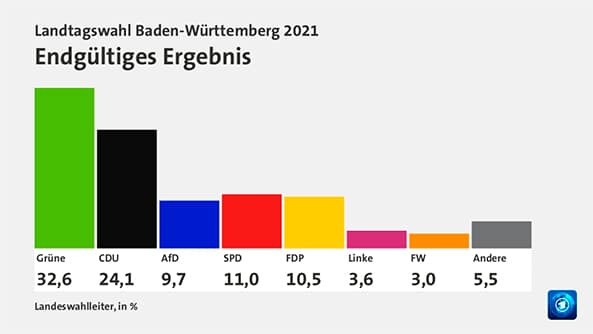
In Rheinland-Pfalz the Greens almost doubled their votes (+4.0% compared with 2016), resulting in a third place after the Social Democrats (SPD) and the Christian Democrats (CDU).
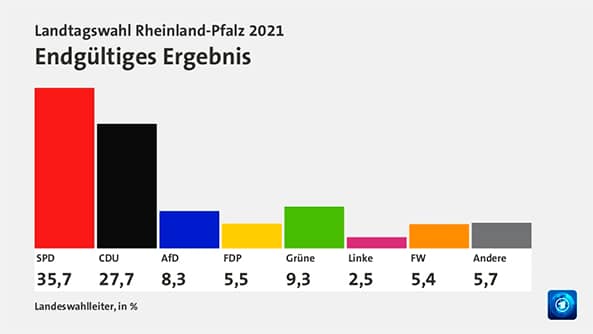
In Sachsen-Anhalt, the CDU gained significantly (+7.4% compared with 2016) amidst predictions that AfD might become the most voted party. The Greens gained slightly (+0.8%) but are historically rather weaker in the ‘new’ Länder compared with the ‘old’ ones.
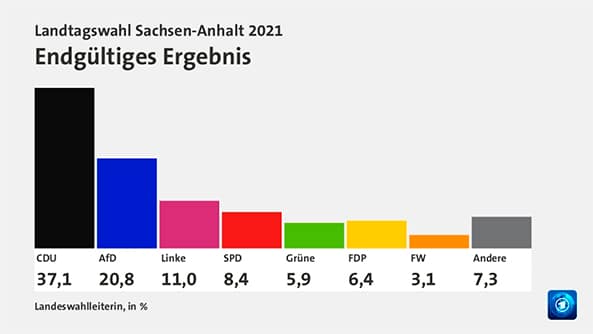
In the General Elections of 26 September 2021 and those in the Länder of Thüringen, Berlin and Mecklenburg-Vorpommern, other parties increasingly also incorporated green political positions, but to varying degrees. Hence, the realisation of the German NRRP’s and similar sustainability-oriented politics and programmes seems very likely after the German ‘super election year’ of 2021.
If the Greens form part of the next Federal Government, which at present seems very likely, the efforts regarding climate policy and energy transition are expected to increase significantly, even beyond the mandatory changes ruled by the Federal Constitutional Court.
Conclusions
Summary and policy recommendations
European cooperation and a green recovery are the two guiding principles of the German NRRP. As such, Germany follows its previous commitments in those areas and is in line with other strategic documents, plans and national laws, such as the NECP, the Climate Action Plan and Programme, the national Hydrogen Strategy and the Energy Transition Laws.
The central pillars of the German NRRP are renewable (green) hydrogen, climate-friendly mobility and climate-friendly construction and renovation. One of the largest individual programmes is the Franco-German initiative towards a hydrogen economy. The German NRRP is designed to be a strategic document for medium-term economic and energy development, hence the focus on more general and ‘lighthouse guiding’ objectives over specific quantifiable targets to be achieved by each individual spending measure.
The German NRRP focuses on the development of a national hydrogen economy and on pursuing worldwide ‘hydrogen leadership’. Hydrogen technologies are aimed to be sped-up and brought closer to market stages through various RD&D programmes. Accompanying regulation focuses on establishing national standards and a policy framework with the intention of negotiating with European partners to create a European framework in the future.
The plan also aims at to accelerate the transformation to sustainable mobility (mainly electric mobility but also hydrogen-based mobility for hard-to-electrify transport). Therefore, expanding infrastructure comprising electrical charging and hydrogen refuelling points is a key priority. Also, individual vehicle and vehicle fleet renewal programmes are to be set up. Several other changes, such as in the area of taxation, complement the incentives for the population to switch to sustainable mobility.
The execution of these measures is considered to be a certainty, as the German Bundestag already approved the budget in December 2020. With potential upcoming changes in the political landscape on the Federal and Länder levels, and with the Green Party rising in importance, the levels of ambition with regards to sustainability criteria objectives may increase throughout the execution of the plan or in subsequent programmes.
Immediate improvement of the German NRRP may be achieved by incorporating quantifiable targets on a per-measure basis that might also serve for ex-post programme evaluation. Also, the different sustainability strategies Germany currently pursues in parallel are not homogenised despite offering a large potential for inter-programme synergies. A common policy framework may help in that respect. Also, such a framework can serve as guidance towards Germany’s climate neutrality targets and be broken down into different areas of public policy and private socio-economic action. Furthermore, within a well-defined framework, individual policy instruments and the design elements within these, may be more effectively devised.
Christoph P. Kiefer
Senior Researcher, Fraunhofer Institute for Systems and Innovation Research ISI | @kiepac
1 This country analysis is based on the German Recovery and Resilience Plan in its draft version from 13/I/2021 as the proposed measures have already been included and approved within the 2021 Budget of the Federal Republic of Germany (‘Federal Budget’) by the German Bundestag on 11 December 2020.
2 Or focus area, as labelled in Figure 4.
3 For instance, by the former Chief of the German Council of Economic Experts (Sachverständigenrat zur Begutachtung der gesamtwirtschaftlichen Entwicklung ‘Wirtschaftsweise’). See Lars Feld at https://www.boersen-zeitung.de/lars-feld-kritisiert-deutschen-wiederaufbauplan-58d58a26-a8e5-11eb-890b-833ddd99a45c.
4 The base year is not explicitly specified, but from the EU Strategy document ‘the Renovation Wave’ and an Answer of the European Commission to the European Parliament it can be understood that it is referred to a 10-year period. Source: https://ec.europa.eu/commission/presscorner/detail/en/ip_20_1835 and https://www.europarl.europa.eu/doceo/document/E-9-2020-005106-ASW_EN.pdf.
5 Carbon contracts for differences (CCfD) are contracts between the Government and a private party in which both agree on a fixed carbon price over a given period of time, shielding the private party from fluctuations of the carbon market price, thus reducing long-term uncertainty and risk and/or to provide a premium over expected future carbon market prices. The Government aim may be to reduce the risk and corresponding financing cost of the private agent, and/or to financially support certain technologies.
6 Baden-Württemberg, Rheinland-Pfalz and Sachsen-Anhalt.



